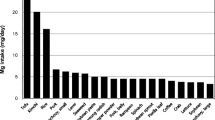Abstract
Magnesium, an element involved in a variety of biochemical and physiological processes in the human body, is closely linked to maintaining health and preventing disease. Even so, studies on the status of magnesium intake have never been conducted sufficiently since only recently a dietary reference intake value was proposed, and data on magnesium contents in food items have always been insufficient. Therefore, in this study, we selected 366 food items commonly consumed by Korean people and then analyzed their magnesium content with inductively coupled plasma atomic emission spectroscopy. With these results, we evaluated daily magnesium intake in 239 healthy adult males and females. Using these 366 values based on magnesium content measurements, we evaluated the status of magnesium intake by our participants and found that the average daily magnesium intake was 279.2 mg, 90.4% of the recommended intake (RI). The results also showed that the magnesium intake by 54.8% of the subjects was lower than the estimated average requirement. In addition to this, the magnesium intake by 45.2% of the cohort was less than 75% of the RI. As such, a high percentage of the subjects showed inappropriate magnesium intake.
Similar content being viewed by others
References
Wester PO (1987) Magnesium. Am J Clin Nutr 45:S1305–S1312
Garfinkel L, Garfinkel D (1985) Magnesium regulation of the glycolytic pathway and the enzymes involved. Magnesium 4:60–72
Swaminathan R (2003) Magnesium metabolism and its disorders. Clin Biochem Rev 24:47–66
Seelig MS (1964) The requirement of magnesium by the normal adult: summary and analysis of published data. Am J Clin Nutr 14:242–290
McNeill DA, Ali PS, Song YS (1985) Mineral analyses of vegetarian, health, and conventional foods: magnesium, zinc, copper, and manganese content. J Am Diet Assoc 85:569–572
Schroeder HA, Nason AP, Tipton IH (1969) Essential metals in man: magnesium. J Chronic Dis 21:815–841
The Korean Nutrition Society (2005) Dietary reference intake for Koreans. Kukjingihoek, Seoul
Institute National Rural Resources Development, Administration RD (2006) Food composition tables, 7th edn. Hyoil, Seoul
Korea Health Industry Development Institute (2003) Development of nutrient database 3: mineral composition of foods. Korea Health Industry Development Institute, Seoul
Resources council, Science and Technology Agency (2000) Standard tables of food composition in Japan. Science and Technology Agency, Tokyo
United States Department of Agriculture (2006) Composition of foods. United States Department of Agriculture, Washington, DC
Ministry of Health & Welfare (2006) Report on 2005 national health and nutrition examination survey - nutrition survey. Ministry of Health & Welfare, Seoul
Keen CL, Ensunsa JL, Watson MH, Baly DL, Donovan SM, Monaco MH, Clegg MS (1999) Nutritional aspects of manganese from experimental studies. Neurotoxicology 20:213–223
Macdonald HM, New SA, Fraser WD, Campbell MK, Reid DM (2005) Low dietary potassium intakes and high dietary estimates of net endogenous acid production are associated with low bone mineral density in premenopausal women and increased markers of bone resorption in postmenopausal women. Am J Clin Nutr 81:923–933
Yoon CS, Bae YJ, Lee JC, Sung CJ (2006) A study on status of magnesium, iron, copper, zinc in Korean obese male elementary school students. J Korean Diet Assoc 12:378–389
Ly SY, Lee HJ (1998) Magnesium intake of Korean college women. Research of Health & Living Science in Cgungnam 11:88–102
Sung CJ, No SL, Kim AJ, Choi MK, Lee JH (1993) Relationship among dietary intakes, blood levels, and urinary excretions of Ca, P, Mg and serum lipid levels in Korean rural adult men and women. J Korean Soc Food Sci Nutr 22:709–715
Sung CJ, Choi YH, Kim MH, Choi SH, Cho KO (2002) A study of nutrient intake and serum levels of osteocalcin, Ca, P, and Mg and their correlation to bone mineral density in Korean postmenopausal women residing in rural areas. Korean J Community Nutr 7:111–120
Ministry of Health, Labour and Welfare (2003) The national survey in Japan, 2001. Japan Government Printing Office, Tokyo
Peacock JM, Folsom AR, Arnett DK, Eckfeldt JH, Szklo M (1999) Relationship of serum and dietary magnesium to incident hypertension: the Atherosclerosis Risk in Communities (ARIC) Study. Ann Epidemiol 9:159–165
Marr KM, Batten GD, Blakeney AB (1995) Relationships between minerals in Australian brown rice. J Sci Food Agric 68:285–291
Acknowledgment
This work was supported by 2007 research grant of Chungwoon University, South Korea.
Author information
Authors and Affiliations
Corresponding author
Rights and permissions
About this article
Cite this article
Bae, YJ., Kim, MH. & Choi, MK. Analysis of Magnesium Contents in Commonly Consumed Foods and Evaluation of its Daily Intake in Korean Independent-Living Subjects. Biol Trace Elem Res 135, 182–199 (2010). https://doi.org/10.1007/s12011-009-8511-x
Received:
Accepted:
Published:
Issue Date:
DOI: https://doi.org/10.1007/s12011-009-8511-x




